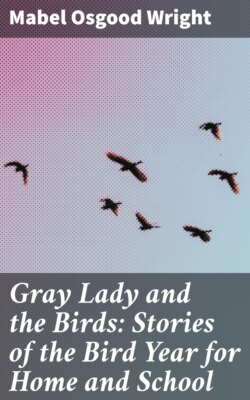Читать книгу Gray Lady and the Birds: Stories of the Bird Year for Home and School - Mabel Osgood Wright - Страница 21
На сайте Литреса книга снята с продажи.
AN ADIRONDACK LUNCH-COUNTER
ОглавлениеTable of Contents
In the Adirondacks in March, 1900, the snow fell over four feet deep, and wild birds were driven from the deep woods to seek for food near the habitation of man. It occurred to me that a lunch-counter with “meals at all hours” might suit the convenience of some of the visitors to my orchard, so I fixed a plank out in front of the house, nailed pieces of raw and cooked meat to it, sprinkled bread-crumbs and seeds around, and awaited results.
The first caller was a Chickadee. He tasted the meat, seemed to enjoy it, and went off for his mate. They did not seem in the least afraid when I stood on the veranda and watched them, and after a time paid but little attention to the noises in the house; but only one would eat at a time. The other one seemed to keep watch. I set my camera and secured a picture of one alone. While focussing for the meat one Chickadee came and commenced eating in front of the camera, and a second later its mate perched on my hand as I turned the focussing screw.
I saw the Chickadees tear off pieces of meat and suet and hide them in the woodpile. This they did repeatedly, and later in the day would come back and eat them if the lunch-counter was empty.
My observation in this respect is confirmed by a lumber-man, who noticed that when eating his lunch, back in the woods, the Chickadees were very friendly and would carry off scraps of meat and hide them, coming back for more, time and time again.
The next day another pair of Chickadees and a pair of White-breasted Nuthatches came. The Nuthatches had a presumptuous way of taking possession, and came first one and then both together. The Chickadees flew back and forth in an impatient manner, but every time they went near the meat the Nuthatches would fly or hop toward them, uttering what sounded to me like a nasal, French no, no, no, and the Chickadees would retire to await their turn when the Nuthatches were away.
The news of the free lunch must have travelled as rapidly in the bird world as gossip in a country town usually does, for before long a beautiful male Hairy Woodpecker made his appearance, and came regularly night and morning for a number of days. Hunger made him bold, and he would allow me to walk to within a few feet of him when changing plates in the camera. It was interesting to note his position on the plank. When he was eating, his tail was braced to steady his body. He did not stand on his feet, except when I attracted his attention by tapping on the window, but when eating put his feet out in front of him in a most peculiar manner. This position enabled him to draw his head far back and gave more power to the stroke of his bill, and shows that Woodpeckers are not adapted for board-walking.
Of course, the smaller Downy Woodpeckers were around; they always are in the orchard toward spring. I also had a flock of Redpolls come a number of times after a little bare spot of ground began to show, but, although they ate seeds I put on the ground, they would not come up on the lunch-counter and did not stay very long. Beautiful Pine Grosbeaks came, too, but they preferred picking up the seeds they found under the maple trees. The American Goldfinches, in their Quaker winter dresses, called, but the seeds on some weeds in the garden just peeping above the snow pleased them better than a more elaborate lunch, and saying “per-chic-o-ree” they would leave.—F. A. Van Sant, Jay, N.Y., in Bird Lore.
“Now, while you move about and rest yourselves a few moments, I will ask Dave and Tommy to bring that picture of the great white bird from the easel and place it by the table here, while I look in this portfolio for another to put with it. See—here is a bird that is much taller than the men beside it and wears bunches of plumes on tail and wings. These two birds represent the wrong and right side of feather wearing!
“What are their real names? The Snowy Heron and the Ostrich, both birds of warm climate. I’m always glad when children wish to know the real names of birds and try to remember them. No one can become actually a friend of a person or an animal whose name is merely general. Has Miss Wilde ever read you a little poem there is about the pleasure of learning real names? No? I will repeat it and perhaps she will let you learn it next Friday.”
